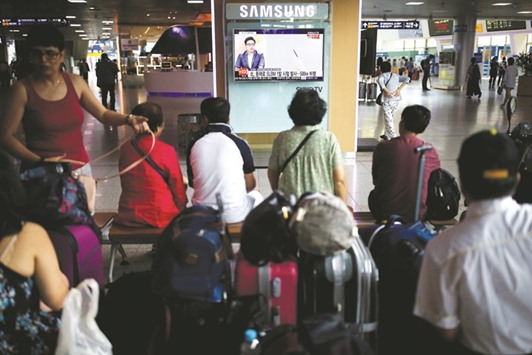North Korea yesterday test-fired a submarine-launched missile 500 kilometres towards Japan, marking what weapons analysts called a clear step forward for its nuclear strike ambitions.
The flight distance, which was tracked by South Korea’s military Joint Chiefs of Staff, far exceeded any previous SLBM tests, suggesting significant progress in technical prowess.
A proven SLBM system would take North Korea’s nuclear strike threat to a new level, allowing deployment far beyond the Korean peninsula and a “second-strike” capability in the event of an attack on its military bases.
“While there are still a lot of questions about the details, this test certainly seems to have been successful,” said Jeffrey Lewis, director of the East Asia Non-proliferation Programme at the Middlebury Institute of International Studies in California.
“This system is still in development, but North Korea is clearly making progress,” Lewis said.
South Korea’s Yonhap news agency cited a military source as saying yesterday’s launch had been made at an acute angle to limit the missile’s range.
If fired at the optimum angle, it could cover more than 1,000km, the source said.
Current UN resolutions prohibit North Korea from any use of ballistic missile technology, but Pyongyang has continued to carry out numerous launches following its fourth nuclear test in January.
South Korea has responded by agreeing to deploy a sophisticated US anti-missile system — known as THAAD — a move that has seriously strained relations with North Korea’s main diplomatic ally, China.
Lewis noted that an SLBM was an “effective countermeasure” to THAAD, and other missile systems with forward-looking radars, since the submarine can launch the missile from behind the radar. Japanese Prime Minister Shinzo Abe said yesterday’s missile breached his country’s Air Defence Identification Zone (ADIZ) and condemned what he called an “unforgivable, reckless act.”
Earlier this month, North Korea fired a land-launched ballistic missile directly into Japanese-controlled waters for the first time, drawing an outraged response from Tokyo.
The latest test came just days after North Korea threatened a pre-emptive nuclear strike against South Korean and US forces who kicked off their annual “Ulchi Freedom” military drill on Monday.
Seoul and Washington insist such joint exercises are purely defensive in nature, but Pyongyang views them as wilfully provocative.
The South’s Joint Chiefs of Staff statement said that the North was clearly bent on escalating tensions and said the SLBM test posed a “serious challenge” to security on the Korean peninsula.
“We will deal strongly and sternly with any provocation by the North,” it said.
Washington also condemned the test and Pentagon spokesman Gary Ross said US commitment to the defence of allies South Korea and Japan remained “ironclad.” Beijing expressed its opposition to North Korea’s nuclear and missile development hours after Pyongyang’s missile launch.
“China is opposed to North Korea’s nuclear and missile development process and any actions that trigger tensions on the Korean peninsula,” Chinese Foreign Minister Wang Yi said Wednesday after a meeting with the foreign ministers of Japan and South Korea in Tokyo.
The Ulchi Freedom drill plays out a scenario of full-scale invasion by the nuclear-armed North.It is largely computer-simulated but still involves around 50,000 Korean and 25,000 US soldiers.

Passengers watch a TV screen broadcasting a news report on North Korea’s submarine-launched ballistic missile fired from North Korea’s east coast port of Sinpo, at a railway station in Seoul yesterday.
